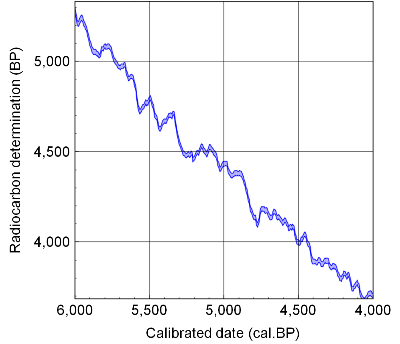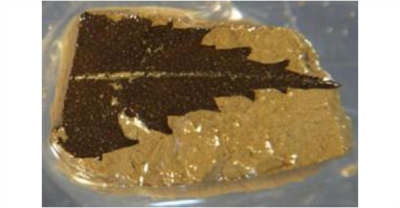
for 14C dating from the SG06 sediment core:

|
|
 |
|
for 14C dating from the SG06 sediment core: |
 |
One of the principal aims of the "Suigetsu Varves 2006" project is to provide a purely terrestrial radiocarbon calibration dataset for the entirety of the radiocarbon timescale (covering, approximately, the last 60,000 years).
Calibration is a necessary stage of the radiocarbon (14C) dating methodology, since the relationship between radiocarbon- and 'true', calendar time has long been known not to be linear. If researchers in the Quaternary sciences or archaeological sciences are to gain a meaningful age from the radiocarbon determinations of their samples, then they must be compared to 14C measurements from material of known age. For the younger part of the radiocarbon timescale, this is provided by dendrochronologically- (tree-ring) dated wood, but prior to the current limit of this tree-ring record (12,550 calendar years before present), no such data exist. Comparisons must therefore be made with the marine record, although this contains additional uncertainties due to the temporally variable 'marine reservoir effect', which causes the marine 14C record to lag that of the contemporaneous atmospheric signal.
The annually laminated (varved) sediments of Lake Suigetsu provide an ideal sequence from which to derive a wholly terrestrial extension to the atmospheric radiocarbon calibration curve through 14C dating of plant macrofossils (leaves, twigs etc.) identified from within its sedimentary strata. This annual lamination of the lake sediments is crucial, since it provides a continuous, independent chronology to which the 14C determinations can be directly related.
The "Suigetsu Varves 2006" project has received funding from the Natural Environment Research Council (NERC, UK) to provide approximately 600 radiocarbon determinations of plant macrofossils retrieved from the Lake Suigetsu (SG06) sediment core, half of which were measured at the Oxford Radiocarbon Accelerator Unit (ORAU; based at the Research Laboratory for Archaeology and the History of Art, University of Oxford), and half of which were measured at the NERC Radiocarbon Facility-Environment (NRCF-E) (hosted by the Scottish Universities Environmental Research Centre (SUERC), East Kilbride.
Publications
Radiocarbon calibration data (comprising ~300 14C determinations) produced from the original (1993) coring of Lake Suigetsu were provided by:
Early in the progress of the "Suigetsu Varves 2006" project, Staff et al. (2010) provided a purely statistical re-analysis of this previous radiocarbon calibration dataset, assessing the extent of the potential error in the previous work. The paper concluded that the coring methodology applied in the 1993 project, resulting in missing sections of sediment between successively drilled sections of the sediment core, was primarily responsible for the deviations identified between the Suigetsu data and the alternative available (marine-derived) datasets. This issue was learnt from for the re-coring of Suigetsu for the "Suigetsu Varves 2006" project.
In 2011 Staff et al. published the first radiocarbon data produced from the "Suigetsu Varves 2006" project. This paper, entitled, "New 14C determinations from Lake Suigetsu, Japan: 12,000 to 0 cal BP" presented radiocarbon measurements from the upper 15 m of the SG06 sediment core. Through comparison with the tree-ring portion of the IntCal09 radiocarbon calibration curve (Reimer et al. 2009), the paper demonstrated that the terrestrial plant material picked from the Lake Suigetsu sediment does indeed provide a reliable archive of past atmospheric 14C. The paper therefore supports the site as being capable of providing a high-resolution extension to the "wholly terrestrial" (i.e. non-reservoir-corrected) calibration curve beyond its present 12,550 cal. BP limit.
This extension to the terrestrial radiocarbon calibration curve was published by Bronk Ramsey et al. (2012) in the journal, Science ("A complete terrestrial radiocarbon record for 11.2 to 52.8 kyr B.P.". Science 338 (6105), 370-374). An accompanying 'Perspective' piece was also given by Reimer (2012) ("Refining the radiocarbon time scale". Science 338 (6105), 337-338.) The full radiocarbon calibration dataset, as published in this paper, is available here, both as an Excel spreadsheet and as a .14c file (5-point average data, including Δ14C).
As was originally hoped, the Suigetsu 14C dataset has now been incorporated into an updated version of the international consensus 14C calibration curve, which has recently been published by Reimer et al. (2013).